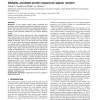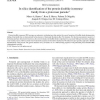294 search results - page 6 / 59 » Predicting the beta-helix fold from protein sequence data |
BIOINFORMATICS
2010
13 years 7 months ago
2010
Motivation: To test whether protein folding constraints and secondary structure sequence preferences significantly reduce the space of amino acid words in proteins, we compared th...
BMCBI
2007
13 years 7 months ago
2007
Background: Predicting a protein’s structural class from its amino acid sequence is a fundamental problem in computational biology. Much recent work has focused on developing ne...
BMCBI
2006
13 years 7 months ago
2006
Background: The emerging field of integrative bioinformatics provides the tools to organize and systematically analyze vast amounts of highly diverse biological data and thus allo...
BMCBI
2008
13 years 7 months ago
2008
Background: Protein sumoylation is an essential dynamic, reversible post translational modification that plays a role in dozens of cellular activities, especially the regulation o...
CANDC
2008
ACM
13 years 7 months ago
2008
ACM
Protein disulfide isomerase (PDI) enzymes are eukaryotic oxidoreductases that catalyze the correct formation of disulfide bonds during protein folding. Structurally they are chara...


